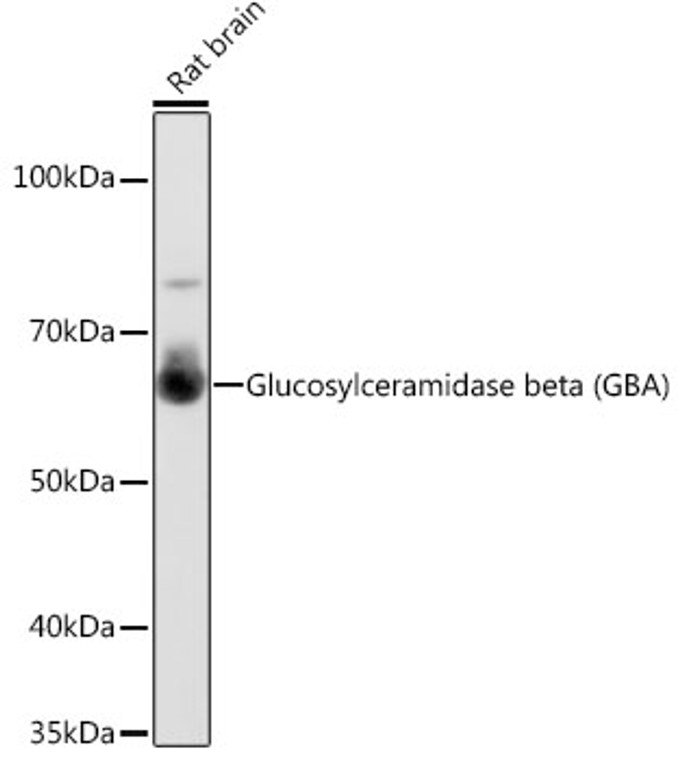| Host: |
Rabbit |
| Applications: |
WB/IHC |
| Reactivity: |
Human/Rat |
| Note: |
STRICTLY FOR FURTHER SCIENTIFIC RESEARCH USE ONLY (RUO). MUST NOT TO BE USED IN DIAGNOSTIC OR THERAPEUTIC APPLICATIONS. |
| Short Description: |
Rabbit monoclonal antibody anti-GBA (437-536) is suitable for use in Western Blot and Immunohistochemistry research applications. |
| Clonality: |
Monoclonal |
| Clone ID: |
S5MR |
| Conjugation: |
Unconjugated |
| Isotype: |
IgG |
| Formulation: |
PBS with 0.02% Sodium Azide, 0.05% BSA, 50% Glycerol, pH7.3. |
| Purification: |
Affinity purification |
| Dilution Range: |
WB 1:500-1:2000IHC-P 1:50-1:200 |
| Storage Instruction: |
Store at-20°C for up to 1 year from the date of receipt, and avoid repeat freeze-thaw cycles. |
| Gene Symbol: |
GBA1 |
| Gene ID: |
2629 |
| Uniprot ID: |
GBA1_HUMAN |
| Immunogen Region: |
437-536 |
| Immunogen: |
A synthetic peptide corresponding to a sequence within amino acids 437-536 of human Glucosylceramidase beta (GBA) (P04062). |
| Immunogen Sequence: |
VDSPIIVDITKDTFYKQPMF YHLGHFSKFIPEGSQRVGLV ASQKNDLDAVALMHPDGSAV VVVLNRSSKDVPLTIKDPAV GFLETISPGYSIHTYLWRRQ |
| Function | Glucosylceramidase that catalyzes, within the lysosomal compartment, the hydrolysis of glucosylceramides/GlcCers (such as beta-D-glucosyl-(1<->1')-N-acylsphing-4-enine) into free ceramides (such as N-acylsphing-4-enine) and glucose. Plays a central role in the degradation of complex lipids and the turnover of cellular membranes. Through the production of ceramides, participates in the PKC-activated salvage pathway of ceramide formation. Catalyzes the glucosylation of cholesterol, through a transglucosylation reaction where glucose is transferred from GlcCer to cholesterol. GlcCer containing mono-unsaturated fatty acids (such as beta-D-glucosyl-N-(9Z-octadecenoyl)-sphing-4-enine) are preferred as glucose donors for cholesterol glucosylation when compared with GlcCer containing same chain length of saturated fatty acids (such as beta-D-glucosyl-N-octadecanoyl-sphing-4-enine). Under specific conditions, may alternatively catalyze the reverse reaction, transferring glucose from cholesteryl 3-beta-D-glucoside to ceramide (Probable). Can also hydrolyze cholesteryl 3-beta-D-glucoside producing glucose and cholesterol. Catalyzes the hydrolysis of galactosylceramides/GalCers (such as beta-D-galactosyl-(1<->1')-N-acylsphing-4-enine), as well as the transfer of galactose between GalCers and cholesterol in vitro, but with lower activity than with GlcCers. Contrary to GlcCer and GalCer, xylosylceramide/XylCer (such as beta-D-xyosyl-(1<->1')-N-acylsphing-4-enine) is not a good substrate for hydrolysis, however it is a good xylose donor for transxylosylation activity to form cholesteryl 3-beta-D-xyloside. |
| Protein Name | Lysosomal Acid GlucosylceramidaseLysosomal Acid GcaseAcid Beta-GlucosidaseAlgluceraseBeta-GlucocerebrosidaseBeta-GcBeta-Glucosylceramidase 1Cholesterol GlucosyltransferaseSgtaseCholesteryl-Beta-GlucosidaseD-Glucosyl-N-Acylsphingosine GlucohydrolaseGlucosylceramidase Beta 1ImigluceraseLysosomal Cholesterol GlycosyltransferaseLysosomal GalactosylceramidaseLysosomal Glycosylceramidase |
| Database Links | Reactome: R-HSA-1660662Reactome: R-HSA-390471 |
| Cellular Localisation | Lysosome MembranePeripheral Membrane ProteinLumenal SideInteraction With Saposin-C Promotes Membrane AssociationTargeting To Lysosomes Occurs Through An Alternative Mpr-Independent Mechanism Via Scarb2 |
| Alternative Antibody Names | Anti-Lysosomal Acid Glucosylceramidase antibodyAnti-Lysosomal Acid Gcase antibodyAnti-Acid Beta-Glucosidase antibodyAnti-Alglucerase antibodyAnti-Beta-Glucocerebrosidase antibodyAnti-Beta-Gc antibodyAnti-Beta-Glucosylceramidase 1 antibodyAnti-Cholesterol Glucosyltransferase antibodyAnti-Sgtase antibodyAnti-Cholesteryl-Beta-Glucosidase antibodyAnti-D-Glucosyl-N-Acylsphingosine Glucohydrolase antibodyAnti-Glucosylceramidase Beta 1 antibodyAnti-Imiglucerase antibodyAnti-Lysosomal Cholesterol Glycosyltransferase antibodyAnti-Lysosomal Galactosylceramidase antibodyAnti-Lysosomal Glycosylceramidase antibodyAnti-GBA1 antibodyAnti-GBA antibodyAnti-GC antibodyAnti-GLUC antibody |
Information sourced from Uniprot.org
12 months for antibodies. 6 months for ELISA Kits. Please see website T&Cs for further guidance







